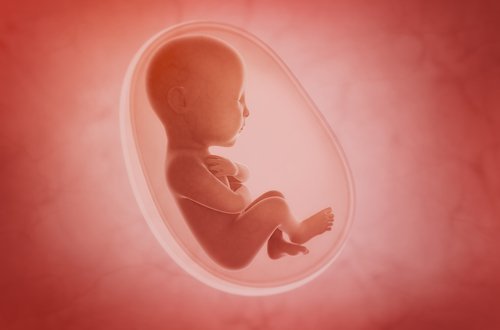What Is Intrauterine Growth Restriction?

Pregnancy is one of the most pleasant moments in a woman’s life. However, it’s also a stage that comes with risks and concerns. One of the complications that may occur is intrauterine growth restriction.
While infrequent, it’s still important to know about this condition.This complication causes the fetus to have a size that is below average.
Below, we’ll present the factors that cause this issue and talk about the prognosis for babies that suffer intrauterine growth restriction.
What is intrauterine growth restriction?
This problem, also know as IUGR, is a medical condition that signals that a baby’s growth is below normal standards. It’s important to mention that these babies aren’t only small, but the velocity of their growth has slowed down while in the uterus.
The consequences of intrauterine growth restriction include low birth weight as well as other complications at birth. Low birth weight refers to that below 5 pounds, 8 ounces.
Types of intrauterine growth restriction
The classification of intrauterine weight restriction will depend, basically, on the origin of the anomaly. Therefore, babies can suffer from symmetric or intrinsic IUGR typical of certain chromosomal defects.
In this case, there is a reduced growth of the entire body, extremities, abdomen and head.

Extrinsic or asymmetric intrauterine growth restriction can also occur, which is usually due to an irregularity in the placenta. In this case, the head may develop normally, while the abdomen and extremities remain small.
At the same time, there is another type of intrauterine growth restriction that is combined. In this case, the condition is the result of unknown causes. It’s important to point out that not all small babies suffer from IUGR.
Therefore, it’s important to rule out factors such as genetic issues. Of course, if the parents are small, the baby is likely to be small as well. At the same time, a baby’s small size can be the result of other pathologies.
Causes of intrauterine growth restriction
The causes of this complication can be diverse. In general, it has to do with the poor functioning of the placenta. This organ connects the mother and the fetus and administers the nutrients that babies need.
However, if the placenta doesn’t function properly, this causes intrauterine growth restriction. Other factors can cause this condition as well, which we’ll look at in closer detail below:
Environmental conditions
Experts believe that pregnant women who live at higher elevations are more prone to give birth to small babies.
This may be due to the amount of oxygen in the air, which is lower at high altitudes. Something similar occurs with future mothers who live in very polluted cities.
“Intrauterine growth restriction is a medical condition that signals that a baby’s growth is below normal standards.”
Harmful habits
Another cause of intrauterine growth restriction can be the mother’s harmful habits – for example, smoking during pregnancy, drug abuse and alcohol abuse. These addictions can cause serious consequences for babies, including very low birth weight.
Illnesses
Illnesses like arterial hypertension, heart defects and metabolic alterations can be to blame. Either of these conditions can reduce the amount of oxygen, vitamins and minerals that reach the placenta. As a result, the fetus is unable to develop appropriately and, therefore, suffers from IUGR.
Furthermore, if the mother is taking medication for these issues, then there is an increased risk of IUGR. In the same way, poor nutrition, performing exhausting tasks, and lack of information can all lead to below-normal birth weights.
Other causes
Other causes that can produce this condition include genetic alterations such as Down Syndrome and Turner Syndrome. IUGR can also be the result of the malformation of fetal organs, infections in the uterus and even cases of multiple birth.
How is IUGR diagnosed?
To detect and diagnose this condition, mothers must undergo proper prenatal controls and ultrasounds. This will allow doctors to observe if blood is flowing correctly to the placenta, as well as this organ’s behavior.
These procedures are simple and routine, and pose no risk. They’re fundamental in preventing greater complications.

What are the chances of survival with IUGR?
In most cases, babies that experience this condition improve quickly after birth. According to their weight, doctors may recommend observing babies in an incubator until they can eat on their own and gain enough weight.
In conclusion, intrauterine growth restriction is a condition that may appear during any stage of pregnancy.
The causes are diverse and a good prognosis is possible. Ideally, mothers should follow the indication of their doctor and undergo all prenatal controls, as indicated.
Pregnancy is one of the most pleasant moments in a woman’s life. However, it’s also a stage that comes with risks and concerns. One of the complications that may occur is intrauterine growth restriction.
While infrequent, it’s still important to know about this condition.This complication causes the fetus to have a size that is below average.
Below, we’ll present the factors that cause this issue and talk about the prognosis for babies that suffer intrauterine growth restriction.
What is intrauterine growth restriction?
This problem, also know as IUGR, is a medical condition that signals that a baby’s growth is below normal standards. It’s important to mention that these babies aren’t only small, but the velocity of their growth has slowed down while in the uterus.
The consequences of intrauterine growth restriction include low birth weight as well as other complications at birth. Low birth weight refers to that below 5 pounds, 8 ounces.
Types of intrauterine growth restriction
The classification of intrauterine weight restriction will depend, basically, on the origin of the anomaly. Therefore, babies can suffer from symmetric or intrinsic IUGR typical of certain chromosomal defects.
In this case, there is a reduced growth of the entire body, extremities, abdomen and head.

Extrinsic or asymmetric intrauterine growth restriction can also occur, which is usually due to an irregularity in the placenta. In this case, the head may develop normally, while the abdomen and extremities remain small.
At the same time, there is another type of intrauterine growth restriction that is combined. In this case, the condition is the result of unknown causes. It’s important to point out that not all small babies suffer from IUGR.
Therefore, it’s important to rule out factors such as genetic issues. Of course, if the parents are small, the baby is likely to be small as well. At the same time, a baby’s small size can be the result of other pathologies.
Causes of intrauterine growth restriction
The causes of this complication can be diverse. In general, it has to do with the poor functioning of the placenta. This organ connects the mother and the fetus and administers the nutrients that babies need.
However, if the placenta doesn’t function properly, this causes intrauterine growth restriction. Other factors can cause this condition as well, which we’ll look at in closer detail below:
Environmental conditions
Experts believe that pregnant women who live at higher elevations are more prone to give birth to small babies.
This may be due to the amount of oxygen in the air, which is lower at high altitudes. Something similar occurs with future mothers who live in very polluted cities.
“Intrauterine growth restriction is a medical condition that signals that a baby’s growth is below normal standards.”
Harmful habits
Another cause of intrauterine growth restriction can be the mother’s harmful habits – for example, smoking during pregnancy, drug abuse and alcohol abuse. These addictions can cause serious consequences for babies, including very low birth weight.
Illnesses
Illnesses like arterial hypertension, heart defects and metabolic alterations can be to blame. Either of these conditions can reduce the amount of oxygen, vitamins and minerals that reach the placenta. As a result, the fetus is unable to develop appropriately and, therefore, suffers from IUGR.
Furthermore, if the mother is taking medication for these issues, then there is an increased risk of IUGR. In the same way, poor nutrition, performing exhausting tasks, and lack of information can all lead to below-normal birth weights.
Other causes
Other causes that can produce this condition include genetic alterations such as Down Syndrome and Turner Syndrome. IUGR can also be the result of the malformation of fetal organs, infections in the uterus and even cases of multiple birth.
How is IUGR diagnosed?
To detect and diagnose this condition, mothers must undergo proper prenatal controls and ultrasounds. This will allow doctors to observe if blood is flowing correctly to the placenta, as well as this organ’s behavior.
These procedures are simple and routine, and pose no risk. They’re fundamental in preventing greater complications.

What are the chances of survival with IUGR?
In most cases, babies that experience this condition improve quickly after birth. According to their weight, doctors may recommend observing babies in an incubator until they can eat on their own and gain enough weight.
In conclusion, intrauterine growth restriction is a condition that may appear during any stage of pregnancy.
The causes are diverse and a good prognosis is possible. Ideally, mothers should follow the indication of their doctor and undergo all prenatal controls, as indicated.
This text is provided for informational purposes only and does not replace consultation with a professional. If in doubt, consult your specialist.








